5period中国翻译史第一讲汇总
- 格式:ppt
- 大小:281.00 KB
- 文档页数:3
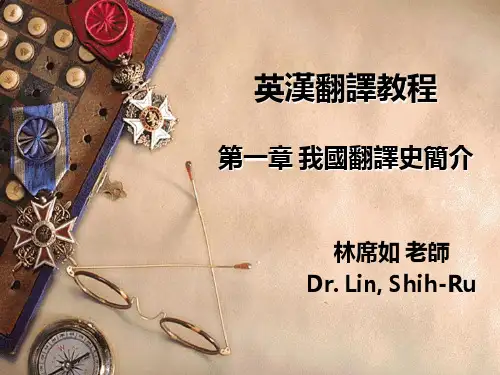
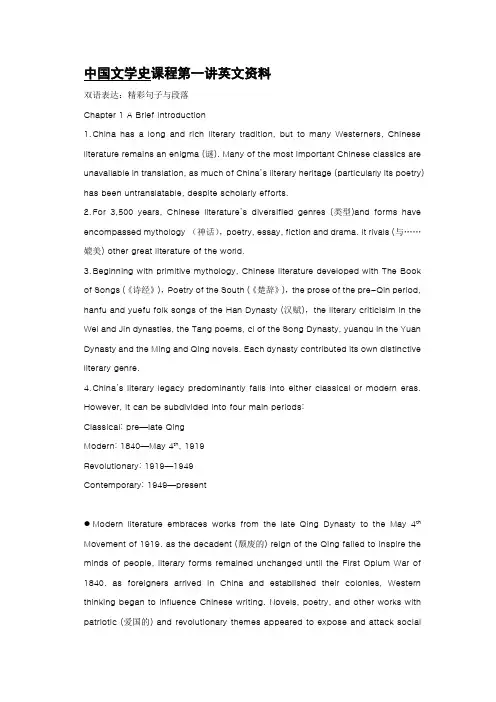
中国文学史课程第一讲英文资料双语表达:精彩句子与段落Chapter 1 A Brief Introduction1.C hina has a long and rich literary tradition, but to many Westerners, Chinese literature remains an enigma (谜). Many of the most important Chinese classics are unavailable in translation, as much of China’s literary heritage (particularly its poetry) has been untranslatable, despite scholarly efforts.2.F or 3,500 years, Chinese literature’s diversified genres (类型)and forms have encompassed mythology (神话),poetry, essay, fiction and drama. It rivals (与……媲美) other great literature of the world.3.B eginning with primitive mythology, Chinese literature developed with The Book of Songs (《诗经》),Poetry of the South (《楚辞》),the prose of the pre-Qin period, hanfu and yuefu folk songs of the Han Dynasty (汉赋),the literary criticisim in the Wei and Jin dynasties, the Tang poems, ci of the Song Dynasty, yuanqu in the Yuan Dynasty and the Ming and Qing novels. Each dynasty contributed its own distinctive literary genre.4.C hina’s literary legacy predominantly falls into either classical or modern eras. However, it can be subdivided into four main periods:Classical: pre—late QingModern: 1840—May 4th, 1919Revolutionary: 1919—1949Contemporary: 1949—presentModern literature embraces works from the late Qing Dynasty to the May 4th Movement of 1919. as the decadent (颓废的) reign of the Qing failed to inspire the minds of people, literary forms remained unchanged until the First Opium War of 1840. as foreigners arrived in China and established their colonies, Western thinking began to influence Chinese writing. Novels, poetry, and other works with patriotic (爱国的) and revolutionary themes appeared to expose and attack socialills.●Revolutionary literature spanned the period from 1919 to the foundation of the People’s Republic of China in 1949 and took on a new vigor, despite the fact that China was in the throes (挣扎) of political and social unrest (骚动). This period was distinctive as it brought along a new and revised literary language, form, content, and set of skills, which evolved into an independent and open art form available to all. It focused on people’s lives with strong political overtones, emphasizing opposition to imperialism and feudalism, and advocating the building of a new China.●Contemporary literature started with the establishment of the PRC in 1949. there was a holdup of development as the consequence of the “cultural revolution” that lasted for nearly 10 years from 1966 to 1976. the era is now long gone and Chinese literature is prospering once again.●Chinese classical literature refers to literary works from the days before the Qin Dynasty to the late Qing Dynasty, and is virtually an unbroken strand (思想等的一个组成部分) enduring dynastic changes.●Long before the written language appeared, there was an oral tradition of tales of fables and legends. Some of them are still kept in some ancient books as a precious heritage of Chinese literature. Over 3,000 years, there has emerged a great variety of excellent works in terms of poems, essays, novels, dramas and so on.●Chinese Mythology 中国神话●Pangu the Creator盘古开天At first the universe was in chaos. Shaped like an egg, it was an undifferentiated whole. Pangu, the Creator, was born into it. He was an almighty giant. He kept growing everyday until he separated the universe into the sky and the earth with his sheer muscular strength. In spite of this the sky and the earth were still connected at various parts. So he kept at his work with a chisel and an axe until the great feat was achieved. He lived for thousands of years, working all the time until he died of exhaustion. When he died, his body changed into various things. His breath became winds and clouds. His left eye turned into the sun and hisright eye the moon. His arms and legs were transformed into the four corners of the earth and parts of his body the various mountains. His blood formed the rivers and his veins the roads. His flesh became the soil and his skin and fine body hair the trees and plants. His teeth and bones turned into rocks and metals and his marrow pearls and jade. His hair and mustache changed into stars. His sweat fell as rain, nourishing all things. The insects on his body took the shape of men and women.●Nuwa, the Maker of Man女娲造人After the birth of the world there were only creatures but no humans. It was indeed a lonely world. The Almighty Goddess Nuwa wanted to add life and beauty to the world. She set about making man with clay. She shaped little figures after her image with her hands. She breathed life into them and set them down. As soon as they touched ground, they began to cheer and dance. She went about her work day and night. It was slow work. When she became tired, the number of creatures she made was still very small. She thought out an idea to speed up the work. She got a rattan, dipped it into the mud and flung the rattan about. The mud drops turned into men and women.●Nuwa mended the Sky女娲补天Once a terrible disaster hit the earth. The sky collapsed and cracked, the earth tilted and split. Endless rains caused fierce floods, crevices in the ground sent out raging fires. Nuwa came out to save the world. She melted rocks of colours to mend the sky. She broke off the legs of a giant turtle and used them to support the four corners of the fallen sky. She killed the black dragon to save the people and checked the flood with reed ashes. Thus the sky was mended and lifted, the cracks of the earth were filled, the fires put out, the flood tamed and the people saved.●The Ancestors of Man兄妹始祖Fuxi(fu xi伏羲) and Nuwa(nv wa女娲)are the ancestors of man. At the beginning of the world there were only two people, Fuxi and Nuwa. They were brother and sister. They wanted to marry each other, but were ashamed of the idea. They decided to climb up to the holy Mountain named Kunlun, the palace of the God of Heaven on earth. They built two fires and prayed: ”If Heaven sent us down to be husband and wife, may the smoke join; if not, the smoke will go different ways.” In no time the smoke joined, they obeyed the decreeof Heaven. Nuwa went up to Fuxi, who took her sister in his arms. Thus they got married.●Myths about man Very conspicuous in Chinese mythology is a lack of detailed myths regarding the origin of man. As already noted, one that is well-known relates that mankind came from the lice on the decaying body of Pan Gu, but Pan Gu is described in another tradition as fashioning men from clay, some of whom were damaged when storm and rain was pressing on and became deformed as a consequence. Nu Wa, the deity who reconstructed the four pillars supporting heaven, was also said to have created men from clay, with the help of other gods and goddesses, some with care, others by dragging a string through mud because they wanted to produce more and faster. Another tale goes that Nu Wa and her elder brother Fu Xi got married, which marked the beginnings of the human race. Later when they found that the young people lived together irregularly, to the great detriment of morality, they prohibited marriage between members of the same family.●Yu the Great, the Flood Tamer大禹治水Gonggong(gong gong共工), the water god was defeated in the power struggle against Zhuanxu(zhuan xu 颛顼), one of the five celestial emperors. In fury, he knocked down the Buzhou Mountain(buzhou shan不周山), one of the pillars of the sky. The sky collapsed, rains poured down, the earth tilted, floods raged. Gun (gun鲧)the Yellow Dragon stole the Growing Earth (xi rang息壤)from heaven in an attempt to block the floods. This failed and he was killed by heaven. Three years after his death, his body was still in good condition. When it was cut open, out bounded his son, the Great Yu(da yu大禹). Yu carried on the unfinished task of his father. Blocking floods by means of dams and dikes was not enough, that was the lesson he drew from his father’s failure. He also dredged rivers and built canals. Yu drove away Gongong the water god and went at his work thirteen years long. The whole earth was inundated. It was slow work. When he was cutting through the most difficult mountain, the Mountain of the Dragon Gate, he turned himself into a bear. When his wife found him in this form, she turned herself into a rock. He lost his wife, but he was not crushed by thismisery. He kept at his work until the floods were tamed and man was saved. And he was revered as Yu the Great.●The Empty Palace of Gods空寂神殿Compared with Greek mythology, Chinese mythology is not very impressive. There is no comparison between it and Greek mythology in amount, Chinese mythology is fragmented, unsystematic. The family trees of gods are not very clear. Much of Chinese mythology is lost, and what is not lost is scattered and difficult to trace. Various causes have been suggested. First, the extremely complicated written word was not efficient in recording myths and legends. Second, Confucius, the most important Chinese philosopher dismissed anything mysterious or fantastic, and that discouraged the spreading of myths. Third, historians before and after Confucius turned much of mythology into historical events and stories. Fourth, Chinese are probably the most historically conscious; even in ancient times early history and mythology were already entwined. As a result, gods became historical figures, and historical figures became gods. No scholars ever thought of systematically recording myths and legends until this century. However, there occurs a brighter side of the picture. Lots of lost myths are still alive among some minority peoples. Much of it has been recorded in the past decades. It won’t be long before Chinese mythology is reconstructed and systematized. 相对于希腊神话,中国神话给人印象不深。
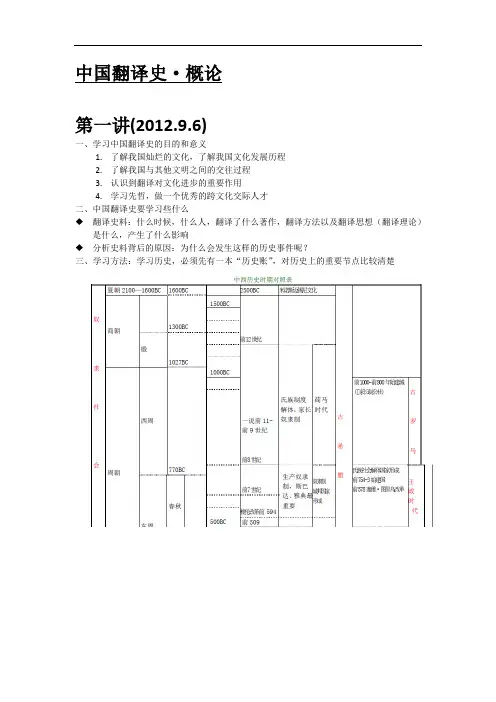
中国翻译史·概论第一讲(2012.9.6)一、学习中国翻译史的目的和意义1.了解我国灿烂的文化,了解我国文化发展历程2.了解我国与其他文明之间的交往过程3.认识到翻译对文化进步的重要作用4.学习先哲,做一个优秀的跨文化交际人才二、中国翻译史要学习些什么◆翻译史料:什么时候,什么人,翻译了什么著作,翻译方法以及翻译思想(翻译理论)是什么,产生了什么影响◆分析史料背后的原因:为什么会发生这样的历史事件呢?三、学习方法:学习历史,必须先有一本“历史账”,对历史上的重要节点比较清楚◆“设身处地”“穿越”到历史情境中◆用历史唯物主义的观点和方法看待历史史料四、中国翻译史的大致分期一般而言,我们把我国的翻译史分为5个时期,称之为“翻译的五个高潮”。
【对于每个翻译高潮,我们都应该提出并解决如下问题:这个时期的翻译家有哪些?各自有些什么贡献?出现这样的翻译现象的历史机缘是什么】1.由汉代到唐宋的上千年的佛经翻译【支谦、道安、鸠摩罗什、昙无谶、法显、谢灵运、真谛、彦琮、慧远、玄奘、不空】2.明清交替之际的科技翻译【徐光启、利玛窦、汤若望、南怀仁、熊三拔、李之藻等】3.清末民初的文学和科技翻译【李善兰、华蘅芳、傅兰雅、林纾、严复、梁启超等】4.民国时期的翻译【鲁迅、赵元任、朱生豪、林语堂】5.新中国成立后的翻译,尤其是改革开放以来的翻译【傅雷、钱钟书、杨绛】五、参考资料(略)第二讲(2012.9.13)一、关于翻译的早期记载◆《册府元龟·外臣部·鞮(di2)译》记载,周时有越裳国“以三相胥重译而献白雉,曰:‘道路悠远,山川阻深,音使不通,故重译而朝’”。
◆《礼记·王制》:“五方之民,言语不通,嗜欲不同。
达其志,通其欲,东方曰寄,南方曰象,西方曰狄鞮,北方曰译。
”这是对翻译官的不同称呼。
后翻译之职,又称“象寄”“象胥”“鞮译”。
又因“夷语与中国相反”,古文把夷语称为“反舌”,而译官又叫“舌人”。
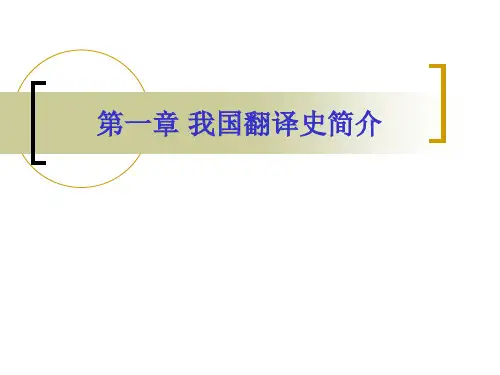
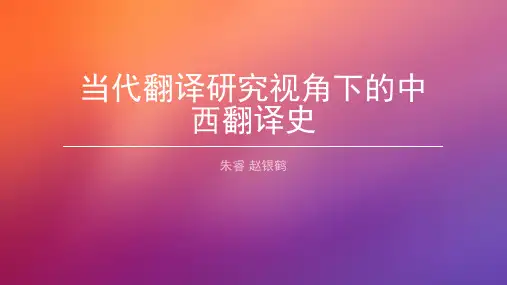
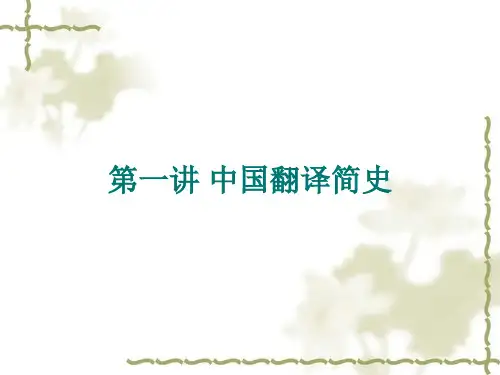
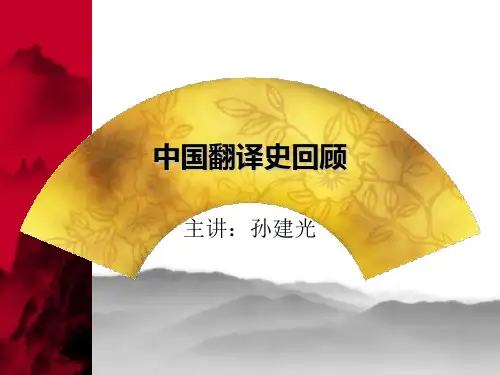
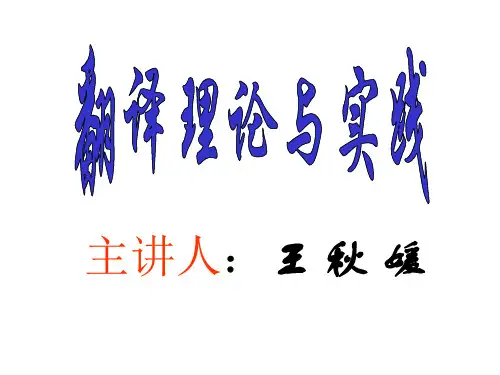
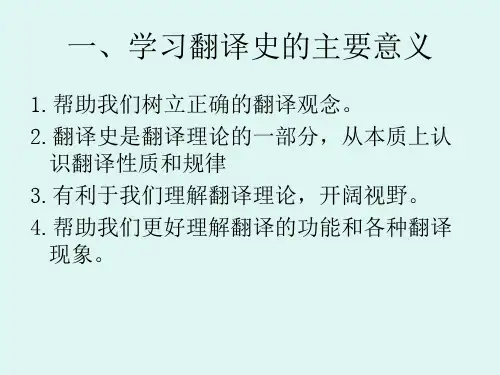
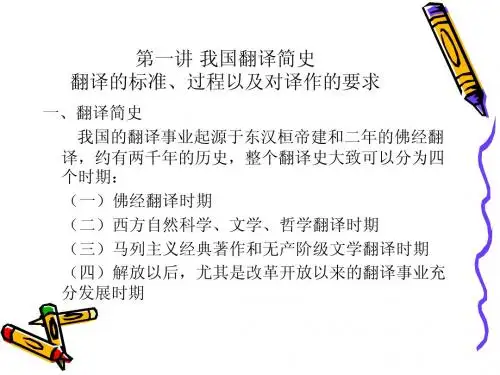
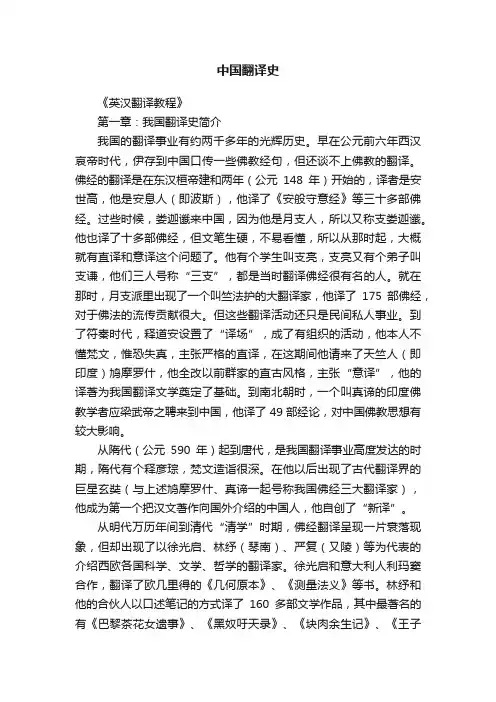
中国翻译史《英汉翻译教程》第一章:我国翻译史简介我国的翻译事业有约两千多年的光辉历史。
早在公元前六年西汉哀帝时代,伊存到中国口传一些佛教经句,但还谈不上佛教的翻译。
佛经的翻译是在东汉桓帝建和两年(公元148年)开始的,译者是安世高,他是安息人(即波斯),他译了《安般守意经》等三十多部佛经。
过些时候,娄迦谶来中国,因为他是月支人,所以又称支娄迦谶。
他也译了十多部佛经,但文笔生硬,不易看懂,所以从那时起,大概就有直译和意译这个问题了。
他有个学生叫支亮,支亮又有个弟子叫支谦,他们三人号称“三支”,都是当时翻译佛经很有名的人。
就在那时,月支派里出现了一个叫竺法护的大翻译家,他译了175部佛经,对于佛法的流传贡献很大。
但这些翻译活动还只是民间私人事业。
到了符秦时代,释道安设置了“译场”,成了有组织的活动,他本人不懂梵文,惟恐失真,主张严格的直译,在这期间他请来了天竺人(即印度)鸠摩罗什,他全改以前群家的直古风格,主张“意译”,他的译著为我国翻译文学奠定了基础。
到南北朝时,一个叫真谛的印度佛教学者应梁武帝之聘来到中国,他译了49部经论,对中国佛教思想有较大影响。
从隋代(公元590年)起到唐代,是我国翻译事业高度发达的时期,隋代有个释彦琮,梵文造诣很深。
在他以后出现了古代翻译界的巨星玄奘(与上述鸠摩罗什、真谛一起号称我国佛经三大翻译家),他成为第一个把汉文著作向国外介绍的中国人,他自创了“新译”。
从明代万历年间到清代“清学”时期,佛经翻译呈现一片衰落现象,但却出现了以徐光启、林纾(琴南)、严复(又陵)等为代表的介绍西欧各国科学、文学、哲学的翻译家。
徐光启和意大利人利玛窦合作,翻译了欧几里得的《几何原本》、《测量法义》等书。
林纾和他的合伙人以口述笔记的方式译了160多部文学作品,其中最著名的有《巴黎茶花女遗事》、《黑奴吁天录》、《块肉余生记》、《王子复仇记》等。
严复是我国清末新兴资产阶级启蒙思想家(曾担任过北大校长),等到八国联军战役以后,他避居上海,搞翻译工作,他“曾查过汉晋六朝翻译佛经的方法”,破天荒第一次在《天演论·译例言》里正面提出了信达雅作为译事楷模。
History of TranslationTeaching PlanTeaching Contents:1. An introduction to Chinese translation theory and history2. An introduction to western countries translation theory and history中国翻译史的大致分期1.由汉代到唐宋的上千年的佛经翻译【支谦、道安、鸠摩罗什、昙无谶、法显、谢灵运、真谛、彦琮、慧远、玄奘、不空】2.明清交替之际的科技翻译【徐光启、利玛窦、汤若望、南怀仁、熊三拔、李之藻等】3.清末民初的文学和科技翻译【李善兰、华蘅芳、傅兰雅、林纾、严复、梁启超等】4. 民国时期的翻译【赵元任、朱生豪、林语堂】5. 新中国成立后的翻译,尤其是改革开放以来的翻译【傅雷、钱钟书、杨绛】Lecture 1 佛经翻译I.关于翻译的早期记载《册府元龟·外臣部·鞮(di)译》记载,周时有越裳国“以三相胥重译而献白雉,曰:‘道路悠远,山川阻深,音使不通,故重译而朝’”。
“五方之民,言语不通,嗜欲不同。
达其志,通其欲,东方曰寄,南方曰象,西方曰狄鞮,北方曰译。
”《礼记·王制》翻译的不同称呼:“象寄”、“象胥”、“鞮译”“舌人”寄send; entrust; rely on象be like; resemble; image译translate; interpret越人歌今夕何夕兮?搴舟中流。
今日何日兮?得与王子同舟。
蒙羞被好兮,不訾诟耻。
心几烦而不绝兮,知得王子。
山有木兮木有枝,心悦君兮君不知。
《越人歌》是我国历史上现存的第一首译诗。
秦汉时期对“翻译官”的种种称谓:“行人”、“典客”、“大行令”、“大鸿胪”、“典乐”、“译官令”、“译官丞”等。
到汉朝,我国主要的外事活动是对北方的匈奴用兵,故翻译活动逐渐用“译”来统称了。
第一讲翻译原则简介第一讲翻译原则简介一、教学目的:了解基本的翻译原则和翻译研究的问题二、教学过程:1.翻译的定义和内涵:(Definition and Connotation)Translation is an art/ science/craft?2.中国几位翻译家的理论(influential translation principles):严复:信达雅--- faithfulness/expressiveness/elegance. The “three character guide”is regarded as a plumb-line of long standing to measure the professional level of translating.傅雷:神似---spiritual conformity. Emphasizing the reproduction of the spirit of the flavor of the original.强调原作神韵再现。
钱钟书:化境---sublimed adaptation. Focus on the translator’s smooth and idiomatic Chinese version for the sake of the Chinese reader.刘重德:信、达、切---faithfulness/expressiveness/closeness.3.中国翻译史上的论争:鲁迅:宁信而不顺---rather to be faithful than smooth。
目的:引入英文句式的表达法梁实秋、赵景深:宁顺而不信---rather to be smooth than faithful 目的:可读性强,便于交流。
4.直译与意译:直译---literal translation 意译:free translation直译的例子:crocodile tears鳄鱼的眼泪; armed to the teeth武装到牙齿; chain reaction连锁反应; gentlemen’s agreement君子协定; one country, two systems 一国两制;The three religions and the nine schools of thought 三教九流; paper tiger 纸老虎; Breath one’s last---断气; go to one’s external rest---安息; the long sleep---长眠; see Marx 见马克思;意译的例子:It rains cats and dogs / at sixes and sevens /Adam’s apple句子比较:Little fish does not eat big fish直译:小鱼不吃大鱼意译:胳膊拧不过大腿试译:天有不测风云,人有旦夕祸福:直译:Storms gather without warning in nature and bad luck befalls men overnight.意译:The weather and human life are both unpredictable5.归化与异化(domestication/adaptation or foreignization / alienation)归化的翻译在理论上是把语言看作交际工具;在实践上,强调通俗易懂,避免多义或歧义。